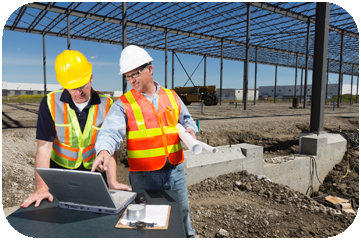Civil Geotechnical Engineering Services for Commercial and Residential Projects
Civil Geotechnical Engineering Services for Commercial and Residential Projects
Blog Article
How Consulting Engineers Enhance Geotechnical Design Projects: Insights Into Their Experience, Methods, and Collaborative Approaches
Consulting designers are critical in boosting geotechnical design tasks, using their specialized expertise to browse the intricacies of subsurface conditions. Their techniques incorporate a variety of website investigation strategies, consisting of Standard Infiltration Tests (SPT) and Cone Infiltration Examinations (CPT), which inform critical choices during the layout and building stages. Their collective approaches foster interaction among diverse task stakeholders, ultimately forming the project's trajectory. As we take a look at the multifaceted functions these specialists play, it ends up being clear that their payments extend beyond technological competence, prompting a better consider the implications for job success.
Duty of Consulting Engineers
The knowledge of consulting engineers in geotechnical engineering is essential to the effective implementation of construction jobs. These experts play a crucial duty in assessing soil and rock buildings, which are crucial aspects affecting layout and construction decisions. By conducting extensive website examinations, seeking advice from designers accumulate essential data that informs the design process, ensuring projects are improved stable and suitable ground.
Consulting engineers also offer vital understandings into risk administration (geotechnical geologist). They identify possible geotechnical threats, such as landslides, soil liquefaction, and negotiation concerns, making it possible for stakeholders to carry out effective mitigation methods. Their competence help in optimizing structure styles, which can cause considerable cost financial savings and boosted security
Furthermore, getting in touch with designers work as an important link between job owners, designers, and specialists. Their capability to equate complex geotechnical information into workable referrals promotes collaboration and promotes notified decision-making throughout the task lifecycle. This multidisciplinary technique not only boosts job efficiency however also makes certain compliance with governing requirements and best methods.
Key Methods in Geotechnical Engineering

One main method is website examination, which involves conducting field tests and lab analyses to gather information on subsurface problems. Methods such as Criterion Infiltration Screening (SPT) and Cone Infiltration Screening (CPT) are extensively made use of to review dirt stratigraphy and toughness. Additionally, geophysical approaches, including seismic and electric resistivity studies, supply non-invasive ways to assess subsurface features.
An additional critical methodology is numerical modeling, which enables designers to imitate numerous circumstances and anticipate exactly how soil-structure interactions will behave under various loading problems. Finite Element Analysis (FEA) is an usual strategy utilized in this context.
Additionally, the style of foundations, retaining frameworks, and earthworks depends heavily on these methodologies - geotechnical geologist. By incorporating sophisticated analytical tools with area data, speaking with engineers Click This Link can create customized services that address details task difficulties, ultimately adding to the security and security of building projects
Relevance of Dirt Analysis
Dirt analysis acts as a fundamental element in geotechnical design, offering important understandings into the physical and chemical buildings of soil essential for efficient building planning. Recognizing dirt characteristics is vital for identifying its load-bearing capacity, drain behavior, and capacity for negotiation or instability. Comprehensive dirt investigations, consisting of tasting and lab screening, help determine parameters such as dirt kind, wetness web content, thickness, and shear strength.
These analyses notify the option of suitable building and construction techniques and products, ultimately influencing job safety and security and durability. For example, natural dirts may need various structure designs contrasted to granular dirts, necessitating tailored design options. In addition, soil evaluation help in identifying contaminants that could pose risks to human health or the environment, enabling the development of mitigation strategies.
Incorporating soil analysis into the very early phases of job advancement assists to reduce unanticipated difficulties, guaranteeing that engineers can prepare for and resolve possible problems before they rise. By developing a detailed understanding of the site problems, consulting designers can enhance design performance and minimize costs, therefore improving the total success of geotechnical design projects.
Joint Techniques in Projects
Effective geotechnical jobs frequently depend upon joint methods that unite varied competence from various techniques. Efficient cooperation among consulting designers, geologists, ecological scientists, and building professionals is vital for dealing with intricate difficulties and maximizing job outcomes. By leveraging the special skills and Visit Your URL understanding of each team member, tasks can take advantage of a holistic understanding of the site problems, regulative needs, and engineering restrictions.
Regular communication and interdisciplinary conferences facilitate the sharing of insights and foster a society of teamwork. These joint efforts allow the identification of prospective dangers early in the project lifecycle, permitting prompt reduction methods. Integrating responses from stakeholders, consisting of neighborhood areas and regulatory agencies, guarantees that all viewpoints are thought about, boosting task approval and conformity.
In addition, the assimilation of innovative modern technologies, such as Geographic Information Systems (GIS) and Structure Details Modeling (BIM), more boosts cooperation. These devices permit for the real-time sharing of information and visualization of geotechnical problems, promoting informed decision-making. Ultimately, a collaborative approach not just simplifies task implementation yet additionally lays the structure for cutting-edge options to complicated geotechnical design difficulties.
Effect on Job Results

Consulting engineers this link use sophisticated methodologies such as threat evaluation and anticipating modeling, which enhance the precision of project projections. Their ability to integrate cutting-edge technologies, like geotechnical instrumentation and information analytics, even more improves the design and building and construction processes. As a result, jobs experience boosted effectiveness, reduced costs, and reduced delays.
Furthermore, promoting efficient interaction and collaboration among group participants improves analytical abilities. When difficulties arise, a joined front allows for quick recognition of remedies, preventing prospective obstacles. Inevitably, the joint initiatives of speaking with engineers add to greater high quality end results, ensuring that projects meet both regulatory requirements and client assumptions.
Final Thought

Report this page